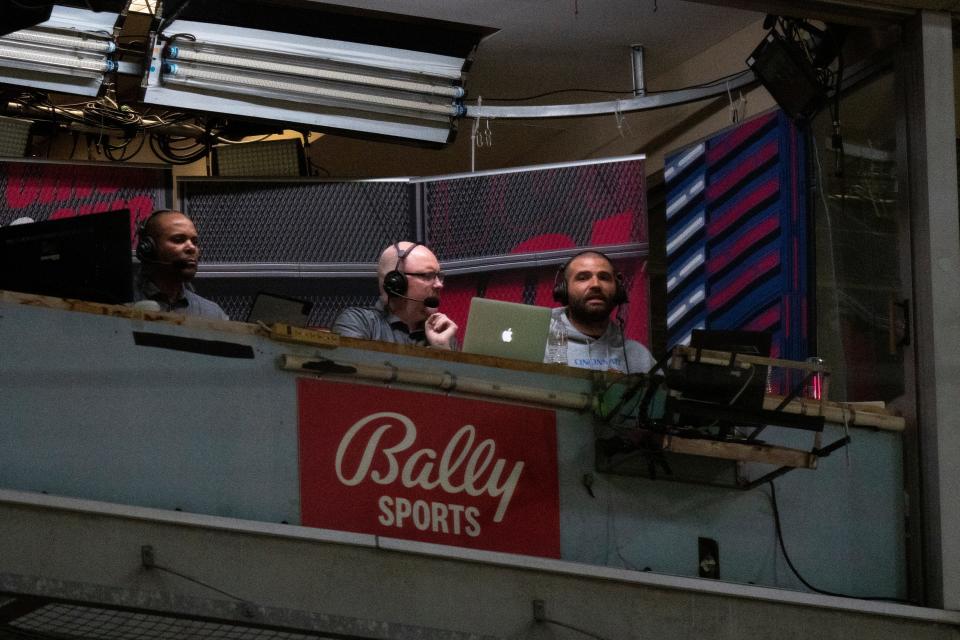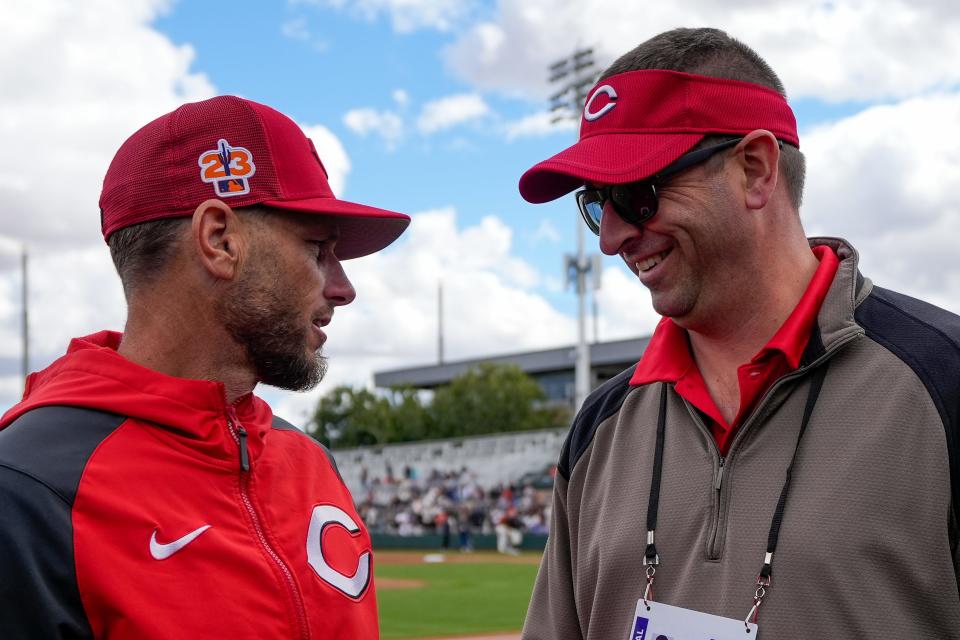Between rock and a hardship? How Cincinnati Reds bracing for looming revenue shortfall
NASHVILLE — The Cincinnati Reds already have signed two pitchers in recent days and are looking for more during the annual winter meetings this week at the Opryland Resort in Nashville, Tennessee.
But as they flirt with free agents and dance with potential trade partners at a level they haven’t done in years, they twerk against a backdrop of revenue uncertainty that could stop the music in a matter of months — or at least significantly change the tune.
Reds trade rumors Cincinnati Reds 2B Jonathan India to 'go with flow' amid winter meetings trade rumors
Reds free agent signings Derek Johnson explains Nick Martinez's fit and the Reds' upcoming rotation battle
Reds Trevor Bauer Cincinnati Reds' Nick Krall on possible Trevor Bauer return: 'Don't see that as an option'
One of 11 remaining MLB teams with local broadcast rights owned by Bally Sports, the Reds could experience an estimated $60 million in annual revenue losses after the 2024 season with Bally’s parent company planning to pull the plug on its remaining broadcast deals after the 2024 season, according to reports on recent filings in its nine-month bankruptcy case.
“Right now we are good,” said Karen Forgus, Reds senior vice-president for business operations. “We’re business as usual for 2024.”

After that? With no obvious local alternative and no clear, immediate remedy through the league, that kind of shortfall could leave the Reds between a rock and a hardship just as they seemed poised to start increasing one of the lowest payrolls in the game into this next-gen competitive window.
Forgus, who met with Bally management Friday during Redsfest to firm up production plans for 2024, wouldn’t comment on contingency plans the team is exploring for 2025 and beyond as the team faces the likely dissolution of a contract that was to run through 2032.
“We are full steam ahead in 2024. That’s what we know,” Forgus said. “We’ve got ’24 in place and we’ve got a good relationship (with Bally Ohio). That’s all we’re going to talk about. Because we just don’t know. You just don’t know what’s coming.”
When Bally defaulted on payments to the San Diego Padres and Arizona Diamondbacks in the past year, it ceded the rights to MLB, which made the games available through its MLB Network franchise, with each team reportedly recouping about 80 percent of its original contract value for those games.
Sources suggest that remedy won’t be available moving forward with 11 more teams impacted — plus the Minnesota Twins, whose contract with Bally expired after 2023.
Reds National Hall of Fame Lou Piniella, former Cincinnati manager, again misses Hall of Fame election by one vote
Reds Elly De La Cruz Elly De La Cruz is ready to play wherever the Reds need him in 2024
The Twins still have no local TV rights partner for 2024, might wind up with games spread across what’s left of the cable “dial” next season and have acknowledged that’s part of what’s behind significant cuts to the payroll of the defending AL Central champions.
The Cleveland Guardians still don’t know whether to expect scheduled quarterly rights payments from Bally in 2024, according to reports in Cleveland, and have consequently decided to sit out the free agent market.
The short-term outlook is a lot better for the Reds, who don’t appear to face such uncertainty in 2024 as they head into their first season of high playoff expectations since before the pandemic.
In addition to two-year contracts for free agent pitchers Nick Martinez and Emilio Pagán, the Reds remain on the hunt for a frontline starting pitcher and appear to have the freedom to entertain contract lengths of three to four years, consistent with their track record in free agency.
Several in the organization thought the team would land former Reds starter Sonny Gray after getting deep enough in negotiations to make an almost identical offer to the three-year, $75 million deal he eventually accepted from the St. Louis Cardinals.
Nick Krall, the Reds baseball operations president, wouldn’t comment on specific players or details. But he’s in almost constant communication with ownership, as usual, this time of year and gave no indication that a looming Bally shortfall has limited his standard operating procedure to this point.

“Nothing’s changed about how we’re doing business this winter,” he said. “We’re looking for ways to make the team better on the field now and for the future.”
Behind the Chapter 11 bankruptcy of Bally’s parent company, Diamond Sports Group (a subsidiary of Sinclair Media), is a heavy debt burden from its 2019 purchase of Fox Sports’ regional sports network (RSN) rights across three leagues and a miscalculation of how fast cord-cutting would change the cable-vs.-streaming dynamic in the ensuing years.
Live sports still represent some of the most valuable content available to a broadcaster, but the severe shift in the distribution model is changing the shape of the landscape almost daily.
MLB may have increased that value with 2023 rules changes that sped up the pace of games and coincided with sharp increases in both league-wide attendance and, for many teams, TV ratings (the Reds included).
“What’s going to happen, bankruptcy or no bankruptcy, is that the media model is going to change,” commissioner Rob Manfred said when asked during the season about how the fallout of the DSG bankruptcy might impact MLB and markets such as Cincinnati. “There will be, I believe, some core of the cable business that stays together, smaller probably than it is today.
“But there will be a corresponding relaxation of exclusivity that allows digital delivery, streaming, delivery, that will significantly increase our reach.”
In other words, broadcast territories assigned to teams now — subject to local blackouts of competing teams’ broadcasts — would go away.
The upside for individual teams in that streaming-world model is the ability to make targeted plays for audiences outside the traditional geographical footprints of fan bases — for example, the Reds tapping into the Toronto market during Joey Votto’s prime.
The downside, of course, is that sports fans make up a minority of television viewers, so a much higher saturation rate of a much smaller pool of potential paying customers is needed to achieve revenue anywhere near the cable RSN model — in which all TV viewers are part of the pool because they often pay for packages that include ESPN and Bally whether they watch those channels or not.
Controlling the emerging streaming-model market for most teams is the natural, desired end game for MLB as a way of decreasing the impact of the historically extreme disparity in local broadcast revenue between the New Yorks and Chicagos of the world and the Milwaukees and Cincinnatis.
Much of those revenues would be shared under an MLB-package product, compared to the my-territory, my-money model of local sports broadcasting in play for decades.
Could that shift eventually put teams with smaller local TV markets and RSN revenues on better competitive footing, relative to larger markets, in that new sports-streaming universe.
“I’m not sure,” Manfred said. “I think the opposite is clearly true. I think the cable model will remain viable in the larger markets longer.”
That would seem especially true in markets such as New York and Chicago, where teams own their own RSNs.
For now, it’s a wild, wild west for nearly half the teams in the majors trying to figure out next steps and alternate revenue for Bally losses looming on the fast-approaching horizon.
Whatever happens after 2024, the Reds say they have no intention of abandoning the road toward contention a group of first- and second-year players suddenly took the team in 2023 after nearly two years of painful cost-cutting and tanking — a post-pandemic rebuild that brought many of those players into the organization in the first place.
“Our priority is always the major leagues; it’s always the players,” Forgus said “So whatever goes on with our financials, whatever that is we’re always going to be focusing on fielding this competitive, sustainable team. That’s the priority no matter what happens.”
This article originally appeared on Cincinnati Enquirer: Cincinnati Reds 'full steam ahead' on roster despite looming shortfall

